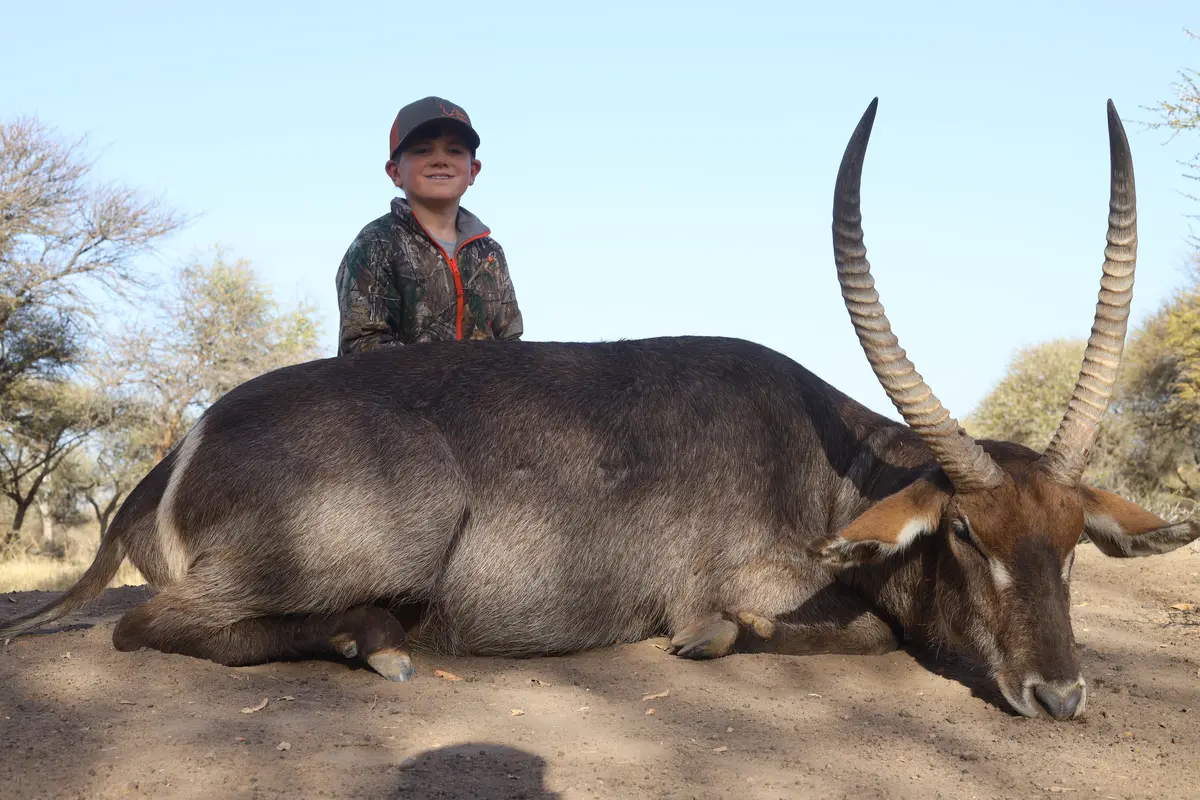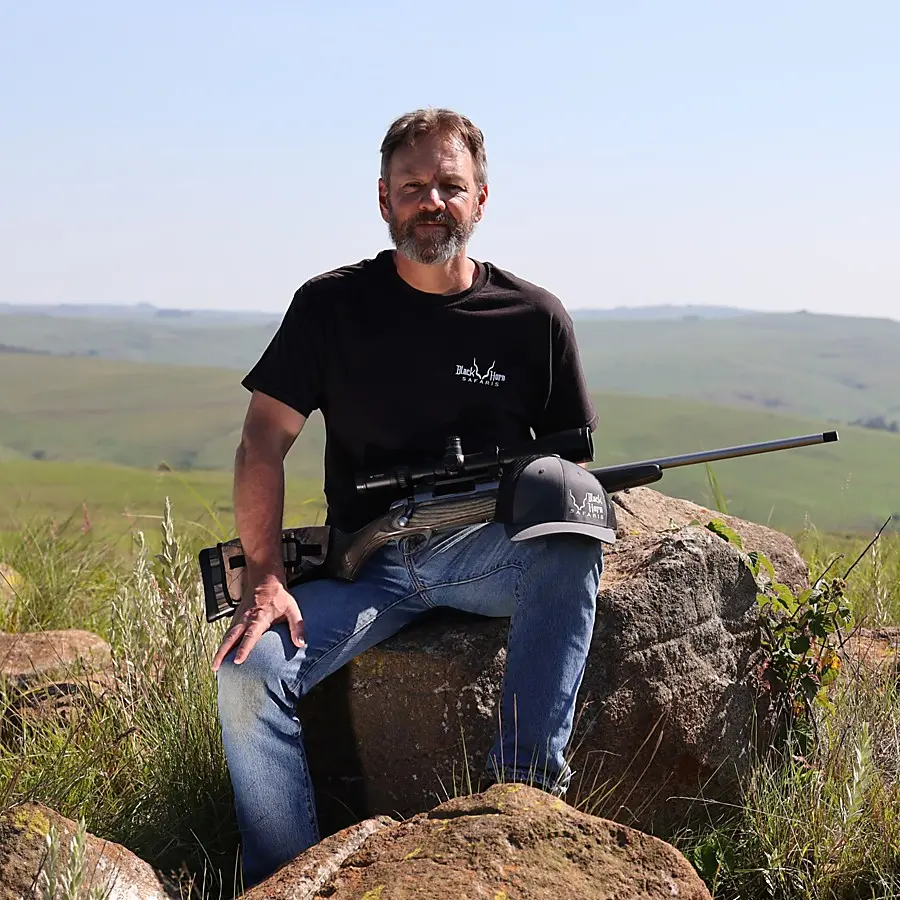
Waterbuck hunting in South Africa is an exhilarating experience that any bow enthusiast would enjoy. With its unique physical characteristics and challenging behavior, the Waterbuck provides a thrilling opportunity for bow hunters looking to test their skills on a bow hunt in South Africa. In this article, we will explore the art of hunting Waterbuck, their habitat, behavior, hunting tips, and the regulations surrounding hunting these majestic creatures.
Understanding the Waterbuck
Waterbuck, scientifically known as Kobus ellipsiprymnus, are large antelopes that inhabit the grassland plains, bushveld, and wetlands of sub-Saharan Africa. These large animals are territorial are considered plains game. They are characterized by their robust build, thick neck and shaggy coat which is grayish-brown, and a distinct white ring or “watermark” around their rump and never far from water. They have good eyesight and are always hard to stalk.
Mature bulls can weigh up to 600 kilograms (1,300 pounds) and shoulder height of 4 feet. Males have long, forward sweeping horns that can reach lengths of up to 35 inches but are more often 30 inches or less.
Waterbuck hunt – Habitat and Behavior
Waterbuck are primarily found near rivers, lakes, and marshlands, hence their name. These cunning animals rely on water sources for both drinking and protection from predators. Their ability to inhabit semi-aquatic habitats makes them resilient and highly adapted to the African bush. They are often found in areas along rivers, or floodplain and come into open grasslands in early mornings and late evenings at dusk.
These antelopes are known for their strong scent, which possibly acts as a defense mechanism against predators. When sensing danger, Waterbuck release a musky secretion that can alert other individuals in the herd. They are also excellent swimmers and will take refuge in water bodies to evade predators like Lions, Leopards, and Hyenas.
Best Areas
Some of the best hunting areas in the country for Waterbuck hunting are the Limpopo province, Eastern Cape, and Mpumalanga. These regions offer diverse and expansive hunting concessions with a mix of bushveld, woodlands, and water sources, which are ideal habitats for Waterbuck. These areas often also have good populations of Kudu and Nyala.
Bow Hunting Tips for Waterbuck in South Africa
Before embarking on a Waterbuck bow hunting trip, it is crucial to be well-prepared, both physically and mentally. Here are some essential tips to enhance your chances of a successful African hunting safari:
Know Your Equipment:
Ensure that you have a well-maintained and accurate compound or crossbow with the appropriate draw weight for trophy Waterbuck (60 to 70 pounds). Practice shooting from different distances and angles to sharpen your skills. Make sure you have the right equipment.
Study Their Habits:
Familiarize yourself with Waterbuck behavior, including feeding patterns, preferred habitats, and daily routines. This knowledge will help you strategize your hunting approach. Trophy Waterbuck are most active during the early morning and late afternoon.
Scouting for a Waterbuck Trophy
Prior to the hunt, scout the area for Waterbuck signs such as tracks, droppings, and feeding grounds. Look for well-worn trails leading to watering holes or rivers, as Waterbuck are creatures of habit and will drink regularly.
Concealment:
Waterbuck have keen senses, particularly their sense of smell. Invest in scent-blocking clothing and scent control products to minimize your scent trail. Camouflage clothing that blends with the surroundings will help you remain unseen.
Shot Placement on Safari
Aim for vital organs such as the heart or lungs when taking a shot. Ensure you have a clear and ethical line to the vitals, shot placement must be good as a Waterbuck is a large animal, known to be tough and have strong bones that your arrow will not penetrate. Many hunters make the mistake of shooting too high, when you have a broadside shot aim just behind the shoulder about a third of the way up from the brisket, this will ensure a heart or lung shot.
Patience and Persistence:
Waterbuck can be cautious and alert, making them a challenging target when in thick brush and then stalked. Exercise patience and be prepared for long waits before getting a good shot opportunity. Rather use ambush techniques by sitting at a vantage point in the thick cover and wait for them to come into open country. The spot and stalk method can be challenging, still hunting is one of the better methods of hunting this game species.
Professional Outfitters and Guides:
Hiring a good hunting outfitter and experienced professional hunters in Africa can significantly increase your chances of a successful Waterbuck hunt. These individuals possess local knowledge, tracking skills, and can ensure you comply with hunting regulations.
Price to Hunt Trophy Waterbuck
The price to bow hunt Waterbuck or trophy fee is $ 2 700 and 7 day hunting package will cost $ 5 150.
Hunting Regulations in South Africa
When planning a Waterbuck bow hunting trip in South Africa, it is essential to adhere to the hunting regulations set by the local authorities. These regulations are in place to ensure sustainable hunting practices and the conservation of wildlife populations. Some key regulations to keep in mind include:
Hunting Permits:
Your hunting company will obtain the necessary hunting permits, permissions and licenses required for a African safari for Waterbuck.
Seasonal Restrictions:
Some areas may have specific hunting seasons or restrictions on hunting during certain times of the year. These restrictions will not apply when you are hunting with an outfitter as all hunting takes place on concessions with exemption and or within the hunting season.
Hunting Code of Conduct:
Follow ethical hunting practices and respect the animals and their environment. Ensure that you only take shots within your effective range and aim for clean, quick kills.
By adhering to these regulations, you can contribute to the conservation efforts and sustainable management of Waterbuck populations in Africa.
In conclusion, an African hunting safari offers an incredible adventure for those seeking a challenging and rewarding hunting experience. Understanding the physical characteristics and behavior of Waterbuck, along with proper preparation will greatly enhance your chances of a successful hunt. Remember to treat these magnificent creatures with respect and appreciation for the opportunity to engage in this thrilling pursuit.
FAQ’s Frequently Asked Questions
What are the physical characteristics of a Waterbuck?
Waterbuck are large antelopes with a robust build, shaggy grayish-brown fur, and a distinct white ring or watermark around their rump. They can weigh up to 1,300 pounds and stand around 53 inches tall at the shoulder. Males have long, forward sweeping horns that can reach lengths of up to 35 inches.
Where are Waterbuck typically found?
Waterbuck are primarily found near rivers, lakes, and marshlands. They rely on water sources for both drinking and protection from predators. Their ability to inhabit semi-aquatic habitats makes them resilient and highly adapted to the African bushveld.
What are some hunting tips for Waterbuck?
Ensure that you have a well-maintained and accurate bow with 60 to 70 pounds of draw weight for Waterbuck. Practice shooting from different distances and angles to sharpen your skills. Familiarize yourself with Waterbuck behavior, including feeding patterns, preferred habitats, and daily routines. They are mostly active in the early morning and late afternoon. Waterbuck have a keen sense of smell and are alert to any signs of danger. Approach your hunting area quietly and patiently, minimizing any noise or scent that could alert the animals.
What are the regulations for Waterbuck?
Specific regulations for Waterbuck may vary depending on the region and hunting company you book with.

Adrian Anderson first obtained his Professional Hunters license in 1991. He is a Big Five and Dangerous Game licensed Professional Hunter and Hunting Outfitter. He has a tremendous love for wildlife and the African bush and enjoys sharing his knowledge with the hunting clients that he guides. Guiding hunters in Africa’s wild places is a passion and seeing them succeed with their goals brings satisfaction. With knowledge of the Safari industry built up over 32 years he is well qualified to give guidance to his hunting clients.
